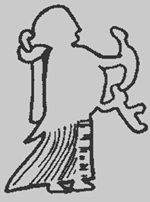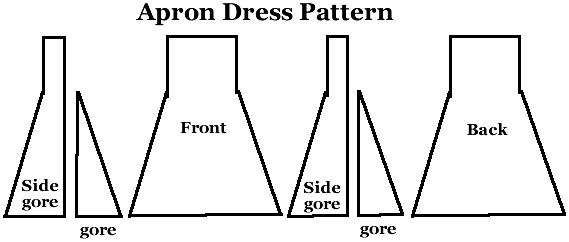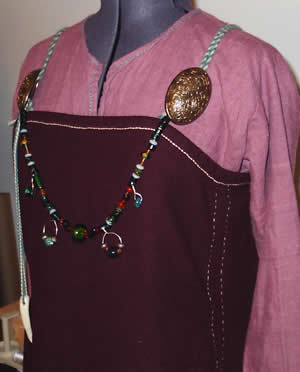
Summary: Being a fan of the Viking age and culture, I wanted to make an apron dress out of wool befitting a lady residing in 10th Century Jorvik, a bustling trader town at that time. After searching the available resources I settled on a pattern that would give a more tailored appearance and yet maintain the geometric shapes and clean lines that seem to have been popular during this time.
Evidence: There have been no surviving in tact apron dresses to universally prove their existence and form. We do have pieces of information that when brought together give a better picture. We also have the art from the times such as the Valkyrie and lovers amulets. Pairs of tortoise shell brooches were found with the imprints of the fibers in the metal on the back, or occasionally with scraps of textile left. The shape and direction of the textiles found indicate that they were once loops to hold an apron dress up at the shoulders. The apron dress itself is believed to have evolved over time from a more shapeless garment to an increasingly tailored dress. There has been some textile fragments with evidence of darts and other techniques for tailoring. A rag found in Hedeby used in caulking a Viking ship was discovered and analyzed with surprising results. The piece was an oddly shaped fragment of wool that was straight on one side, and then straight to a flare on the other. It was hemmed at the top and showed evidence of stitch holes down the two sides that indicated that the piece was attached to others at one point in time. It appears to be the correct shape and size for what I used as a side gore on my apron.
Process:
Pattern: Based on the evidence, and what I have had work in the past, I used the following pattern in assembling this apron. The side gore pieces mimic the described shape of the rag discovered at Hedeby. They also help give a bit more of a tailored fit through the bust and waist of the dress. In actuality the side gores were shorter at the top than the front and back giving a closer fit across the top of the bust and allowing more room to move in the armpits.

Construction: The body of the gown was machine sewn and pieced, as was the reinforcing edge at the top. I chose this method of finishing the top of the apron dress in lieu of a plain hem so that the ends of the apron straps are tucked neatly away. While much later, there is evidence of this type of edge finishing on the neckline of a gown from the Museum of London finds illustrated by Crowfoot, et al. The top edge is finished in a merino wool thread with a reinforcing back stitch to create a solid line across the top. The hem and side seams are flat felled using the same merino wool in a running stitch. Flat felling the seams was a popular seam finishing technique to add a small bit of decoration and a bit of reinforcing as well. While fancier seam finishing stitches could have been used, such as the herringbone stitch, the running stitch was common as well.
For the apron straps I chose to use some whipcording I had made. More common alternatives for constructing the apron straps are to either sew a tube of the same fabric as the dress and use that, or to use some form of tablet woven narrow band. I did not have the time to create tablet woven bands for the straps, but wanted to add a bit more decoration. Whipcording narrow cords for the straps was quick and easy as well as giving me that added decorative element I desired.
 |
 |
 back stich used for top hem |
 detail of running stitch on seams to topstitch them flat, I mangled the gore |
Resources:
Priest-Dorman, Carolyn. A Quick and Dirty Look at Viking Women's Garb in the Ninth and Tenth Centuries. 1999 http://www.cs.vassar.edu/~capriest/qdirtyvk.html
Priest-Dorman, Carolyn and Krupp, Christina. Women's Garb in Northern Europe, 450-1000 C.E.: Frisians, Angles, Franks, Balts Vikings, and Finns. Compleat Anachronist #59, SCA Inc. 1992.
Priest-Dorman, Carolyn. Tenth-century Danish apron dress, a hypothetical reconstruction. 1993 http://www.cs.vassar.edu/~capriest/image/apdress.jpg
Cellio, Monica. The Viking Apron Dress: A New Reconstruction. 1995. http://sca.uwaterloo.ca/mjc/sca/aprond.html
Willadsen, Lisa. 10th Century Danish Clothing. 2003. http://willadsenfamily.org/sca/isabel_as/norse-garb/10th_Century_Danish_Garb.pdf
Crowfoot, Elisabeth; Pritchard, Frances; and Staniland, Kay. Textiles and Clothing c. 1150-c. 1450. Medieval Finds from Excavations in London, 4. London: HMSO, 1992.